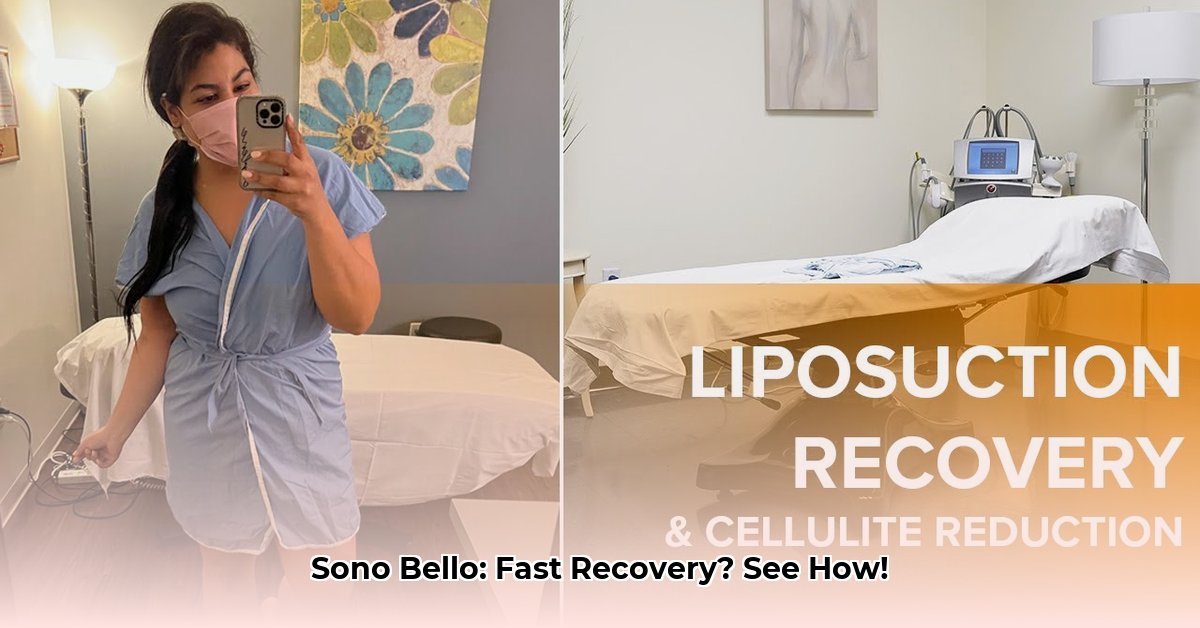
Thinking about Sono Bello laser liposuction? Understanding the recovery process is crucial for making an informed decision. This guide provides a clear, concise overview of what to expect, along with practical steps to optimize your recovery journey. We'll cover the typical timeline, potential complications, and long-term maintenance strategies, all in plain English.
Understanding Your Sono Bello Recovery Timeline
Sono Bello laser liposuction generally boasts a faster recovery than traditional liposuction. While individual experiences vary, most patients experience a recovery period of approximately one to two weeks. However, this timeline can be influenced by several factors, including your overall health, adherence to postoperative instructions, and the extent of the procedure.
Here's a more detailed breakdown:
- Immediate Post-Op (Days 1-3): Expect some swelling and bruising. You'll likely experience mild discomfort and should prioritize rest. Gentle movement is encouraged but avoid strenuous activities.
- Week 1: Swelling starts to decrease, and discomfort lessens. Short walks are usually well-tolerated.
- Week 2 and Beyond: Most swelling subsides. A gradual return to normal activities is possible, but remember to listen to your body and avoid overexertion. More extensive procedures, especially those combining liposuction with other techniques, may require a longer recovery period, potentially extending to several months.
Isn't it reassuring to know that most people see significant improvement within just a couple of weeks? However, remember that individual healing processes vary.
Optimizing Your Sono Bello Recovery: A Step-by-Step Guide
Preparing properly before and after your procedure significantly enhances recovery. Consider these steps:
Pre-Operative Preparation:
- Comprehensive Consultation: Discuss your expectations, concerns, and any potential risks with your surgeon. Thorough communication is key for a successful outcome.
- Dietary Adjustments: Your surgeon may recommend specific dietary modifications prior to the procedure to promote optimal healing.
- Logistics: Arrange for transportation to and from the procedure as you will be unable to drive yourself immediately post-op.
Post-Operative Care:
- Compression Therapy: Wear compression garments as instructed by your surgeon. This is vital for reducing swelling and supporting your skin.
- Pain Management: Follow your surgeon's recommendations for pain relief. Don't hesitate to use prescribed medication as directed.
- Nutrition and Hydration: Maintain a healthy, balanced diet with an emphasis on hydration to aid your body's natural healing process.
- Gradual Activity Increase: Begin with gentle movements and gradually increase your activity level as advised by your surgeon. Avoid strenuous exercise initially.
- Regular Follow-Up Appointments: Attend all scheduled post-operative checkups to monitor your progress and address any concerns promptly.
Did you know that adhering to post-operative instructions significantly impacts recovery time and overall results? Your commitment is an integral part of the process.
Potential Complications and Their Management
While generally safe, complications can arise. Common side effects include swelling, bruising, and pain—most are mild and temporary. Less common complications such as infection or numbness are possible. Contact your surgeon immediately if you experience:
- Excessive pain
- Increased swelling
- Signs of infection (redness, pus, fever)
- Unusual numbness or tingling
Remember, early intervention is key in managing any potential complications. Don’t hesitate to reach out to your medical team for guidance.
Long-Term Maintenance: Sustaining Your Results
Maintaining your results requires commitment to a healthy lifestyle. This includes:
- Balanced Diet: Focus on nutritious foods to support your overall health.
- Regular Exercise: Maintain an active lifestyle to support weight management and overall well-being.
The procedure is a starting point, not a magic bullet. Your ongoing efforts are crucial for lasting results.
Weighing the Pros and Cons of Sono Bello Liposuction
Before making a decision, consider these factors:
Pros:
- Often faster recovery than traditional liposuction.
- Less invasive, typically leading to less downtime.
- Targeted fat reduction in specific areas.
Cons:
- Significant cost.
- Results may vary among individuals.
- Potential for side effects, although typically minor.
Are you ready to weigh the benefits against the potential drawbacks, considering your personal circumstances and health goals? A careful evaluation is critical for informed decision-making.
How to Maintain Sono Bello Liposuction Results Long Term
Maintaining your Sono Bello liposuction results long-term necessitates a commitment to a healthy lifestyle. This involves regular exercise and a balanced diet, similar to maintaining weight loss achieved through other means. The procedure provides a boost, but a sustained healthy lifestyle is crucial for preserving your results.
Key Takeaways:
- Sono Bello liposuction offers a faster recovery time than traditional methods.
- Individual results vary.
- Long-term maintenance requires commitment to a healthy lifestyle.
- The procedure is a significant investment, financially and in terms of ongoing commitment.
- Potential complications exist but are typically manageable.
This information is for general knowledge and does not constitute medical advice. Consult a qualified healthcare professional before making any decisions regarding your health or treatment.